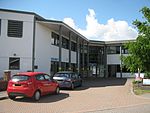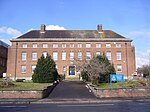West Harnham Chalk Pit
Sites of Special Scientific Interest in WiltshireSites of Special Scientific Interest notified in 1971United Kingdom Site of Special Scientific Interest stubsWiltshire geography stubs
West Harnham Chalk Pit (grid reference SU128287) is a 2.8 hectare geological Site of Special Scientific Interest in Wiltshire, England, notified in 1971. Although named for the West Harnham area in the southwest of the city of Salisbury, the site lies in Netherhampton civil parish. The site is now commonly used by BMX and MTB enthusiasts as a place to exercise their skill on the many formed jumps.
Excerpt from the Wikipedia article West Harnham Chalk Pit (License: CC BY-SA 3.0, Authors).West Harnham Chalk Pit
Frankfurter Straße,
Geographical coordinates (GPS) Address Nearby Places Show on map
Geographical coordinates (GPS)
| Latitude | Longitude |
|---|---|
| N 51.0575 ° | E -1.81874 ° |
Address
Frankfurter Straße
Frankfurter Straße
58553 , Weißenpferd
Nordrhein-Westfalen, Deutschland
Open on Google Maps










